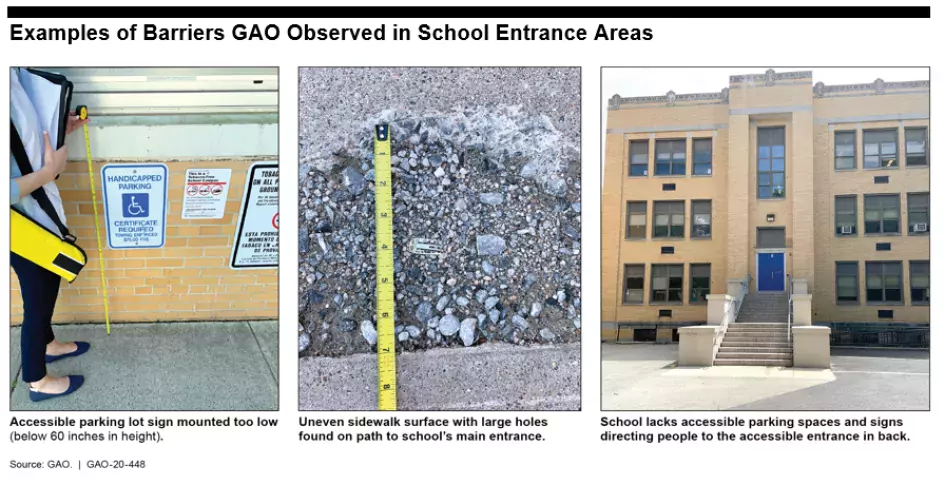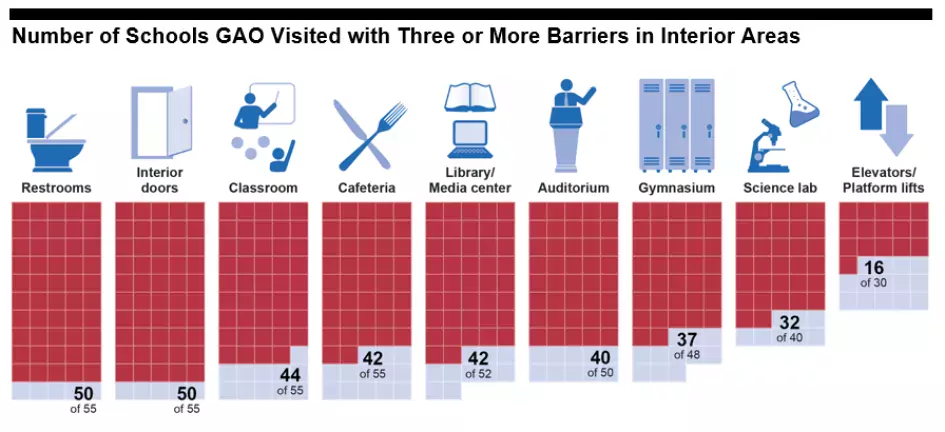It’s the 30th Anniversary of the ADA. What’s Changed?
July 26th marked 30 years since the passage of the Americans with Disabilities Act of 1990. The landmark civil rights law prohibits discrimination against individuals with disabilities in all areas of public life, including education, transportation, employment, and voting. For example, the ADA has had far-reaching implications for the nation’s K-12 public school system.
Today’s WatchBlog discusses recently-issued findings about the state of school facilities, where physical barriers that may limit access for people with disabilities persist, and highlights a selection of our ADA-related work over the years.
Despite progress, most school districts report barriers
In our latest ADA-related findings, GAO conducted a nationally-representative survey of school districts and found that about two-thirds of them had physical barriers that may limit access for people with disabilities. For example, steep ramps at school entrances can make it hard for people with disabilities to safely enter. An estimated 17 percent of districts nationwide—serving 16 million students—have at least one school that may be inaccessible for students with disabilities because of physical barriers.
Note: Barriers are structural or physical features that have the potential to limit access for people with disabilities. In practice, whether a particular barrier limits access depends on the nature of an individual’s disability. Barriers such as those presented in this figure may indicate a lack of physical access, but taken alone, do not establish whether a legal violation has occurred.
GAO toured schools to document potential barriers
We toured 55 schools across 16 districts—in California, Florida, Maryland, Michigan, New Mexico, and Rhode Island—to document physical barriers in various school areas. All of the schools that we visited—regardless of the age or condition of the facility—had multiple barriers that could limit access for people with disabilities. We observed the most barriers at schools that were more than 25 years old.
Note: Not all schools we visited had libraries/media centers, auditoriums, gymnasiums, science labs, or elevators/platform lifts. Barriers are structural or physical features that have the potential to limit access for people with disabilities. In practice, whether a particular barrier limits access depends on the nature of an individual’s disability. Barriers such as those presented in this figure may indicate a lack of physical access but, taken alone, do not establish whether a legal violation has occurred.
Better information could help schools address barriers
When asked what federal assistance might be most helpful, school district and state officials commonly cited a need for training on ADA requirements that is affordable and specific to K-12 public schools.
We recommended that the Department of Justice—the agency responsible for providing technical assistance on the ADA–work with the Department of Education to help school districts and states better understand the ADA and provide technical help tailored to public school issues and needs.
GAO’s history of reporting on ADA compliance
For almost as long as the ADA has existed, GAO has evaluated efforts to comply with the law.
- In 1993, we evaluated access for people with disabilities to goods and services from businesses and state and local governments.
- In 1994, we reported on accessibility challenges facing transit agencies.
- In 2001, we evaluated potential physical barriers at polling places throughout the country.
- In 2011, we examined how federal agencies enforce students’ rights to testing accommodations.
- In 2017, we visited polling places to observe barriers that may impede voting accessibility.
Accomplishments in voting accessibility
In response to GAO’s recommendations, the Department of Justice expanded its Election Day observations to include assessment of the physical accessibility of polling places. Our work also influenced the Help America Vote Act of 2002, which provided funding to improve the accessibility of polling places and requires voting systems used in federal elections to be accessible to individuals with a disability.
- Comments on GAO’s WatchBlog? Contact blog@gao.gov.








